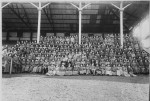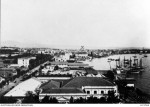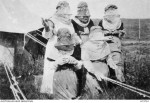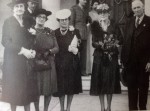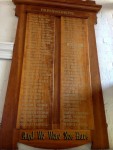PAYNE, Lily May
Lily Payne
Lily and her twin sister Violet both served in the Australian Army Nursing Service during the Great War. (Twins serving were not unknown; twins Catherine and Amelia Uren of SA also joined the AANS). They enlisted and embarked separately and served in different theatres of war but returned to Australia in 1919 on the same ship.
Their lives diverged after the war. Lily married and was widowed, while Violet resumed nursing and became a missionary in Africa for almost two decades, before caring for Lily in her last years.
Lily died aged 77 in 1957.
***
Violet and Lily Payne were the twin daughters of Edward Samuel Payne (1827–1897) and his wife Catherine (nee Walpole) (1840–1922).
Edward had been born in England in 1827 and come to Van Diemen’s Land (Tasmania) with his mother and younger siblings in 1842. They came to join husband and father Edward Payne, a ship’s captain who had regularly carried passengers and cargo between Britain and the Antipodean colonies on the bark ‘Fortitude’. Ashore in Hobart Town in 1841, Payne had purchased the bark ‘Royal William’ which plied the waters primarily between the eastern colonies and New Zealand (Courier [Hobart], 15.12.1840, 2.3.1841, 4.2.1842).
The family settled in Hobart Town, but their lives were disrupted in 1851 when Payne was killed by a gun that discharged accidentally in his cabin during bad weather when the ‘Royal William’ was off the Tasman Peninsula (Courier, 19.3.1851). Mrs Payne and at least some of her children (aged from about 10 to 24) moved to Victoria in the early 1850s. There are no records of the family until the early 1860s, when Edward Samuel Payne, timber splitter, applied for land from the Ballarat Land Commission.
If Edward’s family story had a sad and romantic tinge, so did that of his wife Catherine. Considerable detail had been captured by Sue Ebury in her extensive research into Australian war hero Edward ‘Weary’ Dunlop, Catherine’s grandson (Sue Ebury, Weary: The Life of Sir Edward Dunlop, 1994; much of the information here is from Ebury and the records of the Honourable East India Company). She was born in 1840 in India. Her father, Henry Nagle Walpole (1810–89) was born to schoolmaster George Walpole and his wife Catherine (nee Cade) in Kent, England. Henry would later claim medical and surgical postings with the East India Company after training in England. However in 1836, according to his marriage certificate, he was the schoolmaster sergeant attached to the 2nd Artillery Battalion of the Madras Army run by the East India Company. He instructed the children of non-commissioned officers and soldiers and possibly soldiers as well.
Walpole’s personal life was complex. East India Company records show that in 1836, he married the not quite 15 year old Sophie Matilda Bathe (b 1821) in St Thomas Mount garrison church in Madras (Chennai). One of the three witnesses was M (Maria) A (Angelina) Jackson. Maria was the second wife and widow of Sophie’s father William Bathe and subsequently the widow of William Jackson. Less than a year after his marriage to Sophie, Walpole fathered a son born to Marie Jackson, Thomas Richard Walpole. Thomas was born and baptised in Moulmein, then the capital of British Burma, suggesting that Henry had been transferred well away from Madras. The fate of his wife Sophie Walpole is unclear.
Marie and Henry had another child, Catherine Maria (later to be Violet and Lily Payne’s mother), who was born in Dum Dum near Calcutta (Kolkatta) in 1840. Henry was described as a ‘gunner of artillery’.
Henry and his family arrived in Victoria in 1855 (Ebury, Weary: The Life of Sir Edward Dunlop, p7). His brother, the Rev Joseph Kidd Walpole, had been a clergyman in New South Wales in the 1840s but had returned to England by then; (http://anglicanhistory.org/aus/cci/). Henry’s obituary (Argus, 1.10.1889, p10) described him as a ‘highly educated medical man [who] had seen much service in Burmah, Madras and Central India’, who had turned down medical appointments and who, foreseeing unrest, had left India before the ‘Sepoy revolt’ (1857). According to Ebury’s account, he came with his children, Thomas and Catherine, and third wife, not Maria (of whom there is no record after Catherine’s birth). He took up mining and farming interests in the Ballarat region. Disaffected by life in 1850s Ballarat, Mrs Walpole returned to India with Henry’s papers and their (own) children (Ebury, Weary: The Life of Sir Edward Dunlop, p7).
An inquest in the Victorian town of Bullarook (near Ballarat) in 1862 adds details. Walpole gave evidence on the death of a child whom he had treated. He described himself as a member of the Royal College of Surgeons and qualified medical practitioner who, because he was not qualified to practise in Victoria, offered assistance only in emergencies (Creswick and Clunes Advertiser, 24.1.1862). His health, he said, had been severely affected for twenty years by sunstroke, and he was currently ‘very ill’. He was reprimanded for providing treatment when not legally qualified to do so.
Walpole made a number of purchases from the Ballarat Land Commission, sometimes in conjunction with his son Thomas (e.g. Ballarat Star, 18.9.1866, p4). He raised funds in England (probably through his brother, Joseph Kidd Walpole, a clergyman) for the proposed Church of England in Bungaree. His son Thomas was persuaded to start a school in connection with the church, and became a third Walpole generation teacher as a result (http://www.bungareehistorywalk.com/feedback-blog/first-post). Catherine, his daughter, was multilingual, read Latin and painted (Ebury, Weary: The Life of Sir Edward Dunlop, p7).
In 1866, Catherine married Edward Samuel Payne, who were to be the parents of Lily and Violet. She married against her father’s wishes: Payne was a timber splitter, eking out an income on the edge of the Bullarook forest near Bungaree and purchasing small parcels of land (Ebury, Weary: The Life of Sir Edward Dunlop, p7). Their first four children were born in or near Bungaree between 1867 and 1872. The family moved north to Dookie and then Shepparton where the remaining five children were born between 1874 and 1882, including twins Lily and Violet in 1880. They then moved north east to Whorouly near Oxley, where Henry, Thomas and probably members of Edward’s family had also moved. Family members steadily acquired more land, becoming substantial holders and graziers in the area (e.g. Ovens and Murray Advertiser 13.2.1886, p 11). Thomas, Henry’s son, was also the head teacher at Everton State School near Wangaratta.
Lily Mary and Violet Minnie were twins born to Edward and Catherine Payne in 1880, the couple’s seventh and eighth children. They were educated privately at home, probably by their erudite mother, and then at the Whorouly South Primary School (Payne, Violet, CMS Missionary, SLV MS 13606).
Electoral rolls suggest that in the early 1900s, Lily was living with her younger brother Alfred and their widowed mother on his farm at Whorouly when she decided to train as a nurse. Nursing was already in the family as older sister Catherine trained at Wangaratta Hospital in the early 1900s. Factors that may have also been in play were the death of two siblings in adulthood from typhoid, the death of her father from appendicitis, the return of Violet and the commencement of her nursing career, and a keen desire for independence from her strong-willed mother She was also the twin who had taken the lion’s share of responsibility for bringing up the young son of their sister Alice (Edward Dunlop) during Alice’s ill-health (Ebury, Weary: The Life of Sir Edward Dunlop, pp7-8, 12). Unlike Violet who trained at the Children’s Hospital, Lily trained for three years at the Melbourne Hospital nearby.
After Lily finished training, like twin Violet and sister Catherine she registered her name for nursing positions with Elmore, the trained nurses home at 1101 Hoddle St, East Melbourne. All were on the books of St Peter’s Eastern Hill Church as parishioners and members of the St Barnabas Guild for Nurses. Presumably she nursed in private homes (a common practice) and in the numerous hospitals in East Melbourne and the city. In 1915, she and Violet took over the running of the successful St Alban’s Private Hospital in Wangaratta (Wangaratta Chronicle, 25.9.1915, p2).
War Service
Lily’s younger brother Alfred enlisted and left on active service in mid 1916. Private Alfred Payne was to have an eventful war: wounded in action three times, hospitalised for weeks with influenza/bronchitis, and sentenced to field punishment (including hard labour and loss of pay) on two occasions during hospitalization for refusing to obey orders. After his second serious wounding in mid 1917 he was anxious to return home (Wangaratta Chronicle, 29.9.1917, p4).
His experiences lay ahead. Violet joined the Australian Army Nursing Service (AANS) around the same time at Alfred embarked and left for overseas in December 1916. Reassured no doubt by the presence of her sister Catherine and a paid nurse to look after their aging mother, Lily too enlisted in the AANS in June 1917. She was 37.
If Lily harboured a hope to serve in the same theatres of war as Alfred (of whose woundings she would have been well aware) or Violet, it was not fulfilled. Lily Payne was one of almost 300 nurses despatched under Matrons Jessie McHardie White and Ethelda Uren to Salonika in Greece to serve in British hospitals there. She remained there for the duration of the war.
The fighting on the Macedonian/Salonika front was relatively speaking a sideshow but there had been numerous casualties since 1915. In 1917, the major conflicts were between the British and the Bulgarians. There were several large British hospitals at Salonika which were staffed by British medical officers and Australian matrons and nurses: No 42, 60 and 66 General Hospitals. Nurses were rotated around these large hospitals.
The main contingent for Salonika left on RMS Mooltan and HMAT Wiltshire in June 1917. Payne’s early days at sea were ruined by debilitating seasickness, although the Mooltan was ‘delightful and commands every comfort’ (Wangaratta Chronicle, 29.9.1917, p4; see also Wangaratta Chronicle, 6.10.17, p1)). She disembarked in Egypt on 19 July. After several days billeted in a hotel and presumably filled with excited sightseeing, Payne and colleagues sailed from Alexandria for Salonika through dangerous seas – enemy submarines lurked along the route and the Mooltan had been sunk only the day after the nurses disembarked. She had a quick clear passage of four days.
Lily Payne wrote to her family as she and her contingent approached Salonika Harbour. The harbor itself looked ‘beautiful’ but the view through binoculars was less promising – ‘numerous tents as well as houses situated on the side of some very barren looking hills’ (Wangaratta Chronicle, 10.11.1917, p4).
Her apprehension was justified. While 100 kilometres from fighting, Salonika was a notoriously difficult posting. The patients, mainly British ‘tommies’, suffered from severe malaria and dysentery. Many wards were tented which made for very challenging nursing in the environment as described by Nurse Ruby Dickinson, a colleague of Payne’s and fellow parishioner at St Peter’s Eastern Hill (Matron Kellett Interviews, AWM 41/1072, Australian War Memorial). Dickinson described the patients as ‘depressed [and] lethargic’. The climate consisted of extremes of heat and cold, with limited supplies of water in summer and fuel in winter. The ferocious ‘vardar’ winds made it a challenge to keep personnel, patients and tents upright, to the extent that 60 General Hospital was relocated from the hills to nearer the town during the winter months. The town of Salonika, severely damaged by fire shortly before the nurses arrived, was dirty, unappealing and largely out-of-bounds. Food, fresh food in particular, was in short supply due to the fire and the difficulties of getting supplies through dangerous waters.
Salonika did offer compensations. Spring was almost indescribably beautiful, with intoxicating fields of cornflowers and a climate ideal for sightseeing and picnics. Matron McHardie White and other nurses in their accounts describe a place which was almost Jekyll and Hyde like in its contrasts (Matron Kellett Interviews, AWM 41/1072, Australian War Memorial).
Like most nurses on Salonika, Payne spent time in various hospitals staffed by Australians matrons and nurses. She was primarily attached to 66 General Hospital which was situated in the hills above the town although she had a brief period at 60 General Hospital nearby. Her patients were mainly malaria victims, some with very severe forms of the disease. The nursing involved pioneering treatment methods which proved highly effective.
In November 1917 Lily Payne was transferred to 42 General Hospital, where dysentery patients were housed. Conditions were less than ideal and the hospital was relocated several times. Initially sited on a horse and mule dump on the edge of the town, 42GH was re-established further out, on the edge of a ravine which proved mosquito-infested. It returned to its original site.
Given the circumstances, it is scarcely surprising that many Australian nurses who served at Salonika became ill with malaria and/dysentery. Sixty at least were repatriated back to Australia via England because their health failed.
While Lily Payne was not repatriated before the war ended, she was ill and hospitalised several times in 1918. She had two periods of a fortnight each in the Red Cross Convalescent Home in May and then August/September recovering from debility and an unspecified illness. In late September she was hospitalised for a month with boils and auditory meatus problems. Only days after she rejoined her unit on 31 October she was admitted to hospital again, apparently with dysentery.
It was five weeks before she was well enough to report for duty on 9 December 1918. Despite all her illhealth in her second year at Salonika, Payne was mentioned in despatches for her ‘gallant and distinguished service’.
By the time Payne rejoined her unit, hostilities had ceased and the war was over.
After the war
Lily Payne left Salonika for leave in England in mid February 1919. By then, both her twin sister Violet and younger brother Alfred were in England, awaiting repatriation to Australia. Violet was with 1 Australian General Hospital at Sutton Veny and Alfred was at the convalescent depot at Weymouth, 100 kilometres away.
Once more Lily’s health declined and she spent a fortnight in the hospital for Australian nurses in London, at Southwell Gardens, probably with influenza. Recovered she was posted to 1 Australian General Hospital at Sutton Veny, where she joined Violet.
They returned to Australia as nurses on the same ship, the ‘Wiltshire’. Identical twins, they played tricks on the officers as each pretended to be the other (Butler, Janet. ‘Gone to War as Sister.’ Speech at the Opening, East Melbourne Historical Society Exhibition, 'Gone to War as Sister: East Melbourne Nurses in the Great War', East Melbourne Library, 19 August 2015). They reached Australia on 19 August 1919.
On her return Lily sought a promotion from staff nurse to sister to be applied retrospectively for the entire period of her service in Salonika (Violet had been promoted late in 1918). Her application was supported by the matron of 42 General Hospital who praised her ‘excellent’ work. The application was granted (Lily Payne, Service Record, National Archives of Australia).
Lily, Violet and Alfred reunited with their family in and around Wangaratta. Albert returned to his farm at Whorouly. Violet took over the care of their bedridden mother until Mrs Payne died in 1923. She subsequently moved into child health and spent 18 years in Tanganyika (1928–1946) with the Church Missionary Society.
Lily was still in poor health when discharged from the AANS on 31 January 1920. Her plight of illness, inability to work and no source of income led to her applying for assistance from the Edith Cavell Trust, a fund set up for Victoria’s army nurses in honour of the British nurse shot in 1915. She was granted £10 on 4 February 1920 (Dutton, Lily May, File, Edith Cavell Trust Fund, M290, NAA).
In April 1920 at St Peter’s Church Eastern Hill, Lily married Albert Dutton, a grazier with land near Wangaratta, whom she may well have known for many years. She was widowed when Albert, 17 years her senior, died in 1928.
After Alfred’s death, Lily Dutton moved to Melbourne and ran her own convalescent home as a means of support until her ill-health made this impossible. She remained devoted to her nephew Edward Dunlop, offering financial support when he took up medicine at Melbourne University, and later after he married (Ebury, Weary, pp. 47, 546). Violet, who had returned from Tanganyika in 1946, became Lily’s constant carer as her incapacity worsened. They turned to the Edith Cavell Trust, Lily applying for assistance in 1952, 1954 and 1957, shortly before her death. The applications make sad reading: two Great War nurses who were elderly, their health deteriorating (Lily finally bedridden with heart disease and a stroke) and their incomes ’almost depleted’.
Lily died in on 25 August 1957, aged 77. She was cremated at Springvale Crematorium.
Thank you to Rob Dunlop for drawing attention to the connection between Lily Payne and Edward 'Weary' Dunlop.
Janet Scarfe
Adjunct Research Associate, Monash
Updated 1 February 2016
Can you help?
Can you correct or provide more information about this person?
Or are you able to help with this history project?
- Family stories and records including photos, documents and memorabilia?
- Stories or information in books, newspapers and on-line?
- Memorial plaques in churches and public places?
- War memorial, church, national and state archives?
If so, please Contact the East Melbourne Historical Society.

